Photograph by Ing-On Vibulbhan-Watts
I went to Thailand to visit my family for two months, from July and August 2017. I did not visit home since 2006. I was glad to see my family. I enjoyed seeing all new development in Bangkok and loved eating authentic Thai food, especially Thai fruits.
I had a chance to visit my home town, Lopburi, where I was raised when I was young, before we moved to Bangkok. I traveled to Ayutthaya to see the ruins of temples that were burned by Burmese soldiers, when the Burmese wanted to take over Thailand, The Burmese–Siamese War (1765–1767). Ayutthaya was one of the former capitals of Thailand before moved to, Thonburi and then Bangkok. I also traveled to, Chiang Mai, located in the Northern part of Thailand. Chiang Mai is the second largest and second most popular city of Thailand.
John, my husband came to Thailand in August. He joined me traveling to different part of Thailand. I had a good time taking videos and photographs wherever I traveled around Bangkok and other part of Thailand. I hope the viewers of my website will enjoy the photographs that I present in these projects.
Ing-On Vibulbhan-Watts, Thursday, October 26, 2017
Wat at Chao Phraya River in Bangkok, Thailand
The Chao Phraya Thai: Maenam Chao Phraya, pronounced [m???ná?m t?â?w p?rá?.ja?] or [t?â?w p?ra.ja?][1]) is the major river in Thailand,[2] with its low alluvial plain forming the centre of the country. It flows through Bangkok and then into the Gulf of Thailand.
The Chao Phraya begins at the confluence of the Ping and Nan rivers at Nakhon Sawan (also called Pak Nam Pho) in Nakhon Sawan Province. After this it flows south for 372 kilometres (231 mi) from the central plains to Bangkok and the Gulf of Thailand. In Chai Nat, the river then splits into the main course and the Tha Chin River, which then flows parallel to the main river and exits in the Gulf of Thailand about 35 kilometres (22 mi) west of Bangkok in Samut Sakhon. In the low alluvial plain which begins below the Chainat Dam, there are many small canals (khlong) which split off from the main river. The khlongs are used for the irrigation of the region’s rice paddies.
The rough coordinates of the river are 13 N, 100 E. This area has a wet monsoon climate, with over 1,400 millimetres (55 in) of rainfall per year. Temperatures range from 24 to 33 °C (75 to 91 °F) in Bangkok.
For more information please visit the following links:
https://en.wikipedia.org/wiki/Chao_Phraya_River
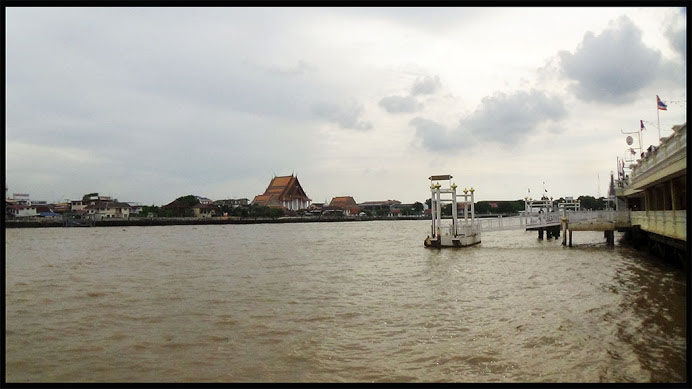
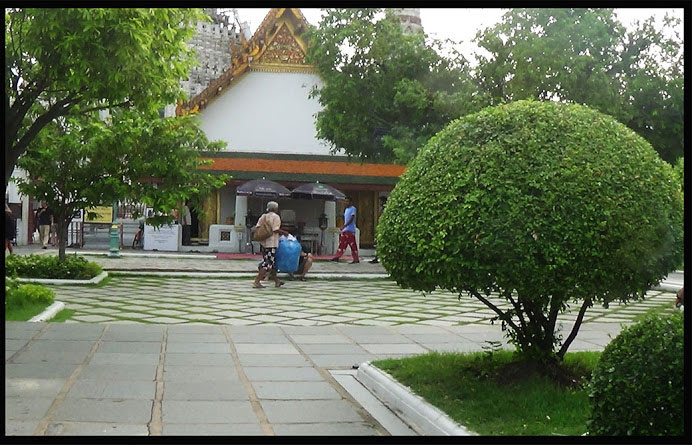 Wat Arun in Bangkok, Thailand
Wat Arun in Bangkok, Thailand
Wat Arun Ratchawararam Ratchawaramahawihan Wat Arun (Thai pronunciation: [wát ?arun], “Temple of Dawn”) is a Buddhist temple (wat) in Bangkok Yai district of Bangkok, Thailand, on the Thonburi west bank of the Chao Phraya River. The temple derives its name from the Hindu god Aruna,[1] often personified as the radiations of the rising sun. Wat Arun is among the best known of Thailand’s landmarks and the first light of the morning reflects off the surface of the temple with pearly iridescence.[2] Although the temple had existed since at least the seventeenth century, its distinctive prang (spires) were built in the early nineteenth century during the reign of King Rama II.
For more information please visit the following links:
https://en.wikipedia.org/wiki/Wat_Arun
Wat Arun at Chao Phraya River in Bangkok, Thailand
Travel
Wat Arun can be easily accessed through the Chao Phraya River, and ferries travel across the river towards the Maharaj pier. For the foreigners, the temple charges an entrance fee of 50 baht (as of December 2016). During Kathina, the king travels to Wat Arun in a procession of royal barges to present new robes to the monks.
For more information please visit the following links:
https://en.wikipedia.org/wiki/Wat_Arun
Wat Arun at Chao Phraya River in Bangkok, Thailand
Cosmology
The central prang symbolises Mount Meru of the Hindu cosmology.[9] The satellite prang are devoted to the wind god, Phra Phai. The demons (yaksha) at the entranceway to the ubosot are from the Ramakien. The white figure is named Sahassa Deja and the green one is known as Thotsakan, the Demon R?vana from Ramayana.
For more information please visit the following links:
https://en.wikipedia.org/wiki/Wat_Arun
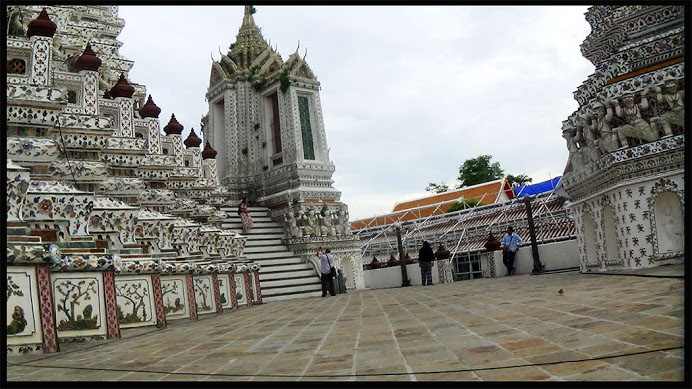 Wat Arun at Chao Phraya River in Bangkok, Thailand
Wat Arun at Chao Phraya River in Bangkok, Thailand
The main feature of Wat Arun is its central prang (Khmer-style tower) which is encrusted with colourful porcelain.[5] This is interpreted as a stupa-like pagoda encrusted with coloured faience.[6] The height is reported by different sources as between 66.8 m (219 ft) and 86 m (282 ft). The corners are surrounded by four smaller satellite prang. The prang are decorated by seashells and bits of porcelain which had previously been used as ballast by boats coming to Bangkok from China.[7]
The central prang is topped with a seven-pronged trident, referred to by many sources as the “Trident of Shiva”.[8] Around the base of the prang are various figures of ancient Chinese soldiers and animals. Over the second terrace are four statues of the Hindu god Indra riding on Erawan.[9] In the Buddhist iconography, the central prang is considered to have three symbolic levels—base for Traiphum indicating all realms of existence, middle for Tavatimsa where all desires are gratified and top denoting Devaphum indicating six heavens within seven realms of happiness.[9] At the riverside are six pavilions (sala) in Chinese style. The pavilions are made of green granite and contain landing bridges.
Next to the prang is the Ordination Hall with a Niramitr Buddha image supposedly designed by King Rama II. The front entrance of the Ordination Hall has a roof with a central spire, decorated in coloured ceramic and stuccowork sheated in coloured china. There are two demons, or temple guardian figures, in front.[9] The murals were created during the reign of Rama V.[9]
For more information please visit the following links:
https://en.wikipedia.org/wiki/Wat_Arun
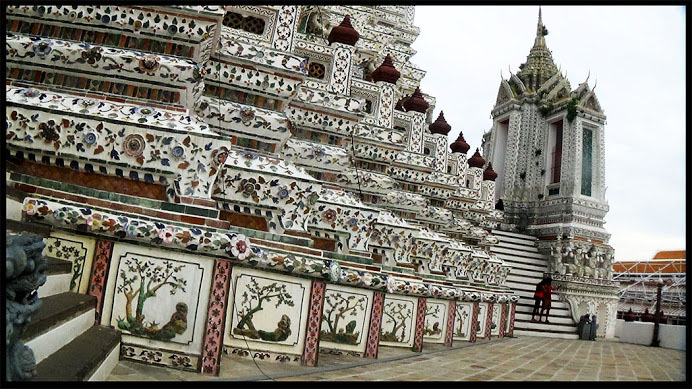


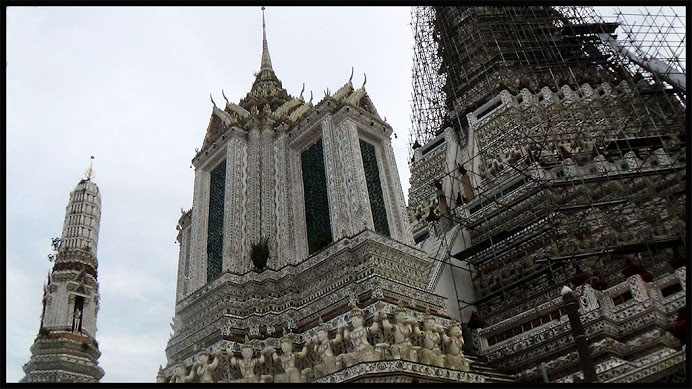

 Wat Arun in Bangkok, Thailand
Wat Arun in Bangkok, Thailand
A Buddhist temple had existed at the site of Wat Arun since the time of the Ayutthaya Kingdom. It was then known as Wat Makok, after the village of Bang Makok in which it was situated. (Makok is the Thai name for the Spondias pinnata plant) According to the historian Prince Damrong Rajanubhab, the temple was shown in French maps during the reign of King Narai (1656–1688). The temple was renamed Wat Chaeng by King Taksin when he established his new capital of Thonburi near the temple, following the fall of Ayutthaya.[3] It is believed that Taksin vowed to restore the temple after passing it at dawn. The temple enshrined the Emerald Buddha image before it was transferred to Wat Phra Kaew on the river’s eastern bank in 1785.[4] The temple was located in grounds of the royal palace during Taksin’s reign, before his successor, Rama I, moved the palace to the other side of the river.[2] It was abandoned, for a long period of time, until Rama II, who restored the temple and extended the pagoda to 70m.[2]
For more information please visit the following links:
https://en.wikipedia.org/wiki/Wat_Arun
 WAT MAHA THAT, Ayutthaya, Thailand
WAT MAHA THAT, Ayutthaya, Thailand
Welcome To My Beloved Country, Thailand
Photograph by Ing-On Vibulbhan-Watts
“Architecture: Wat Maha That as Wat Phra Ram, Wat Phutthai Sawan and the later built Wat Racha Burana follows the Khmer concept of temple onstruction. We find nearly identical, but earlier built structures at Angkor. Phnom Bakheng, Preah Rup, East Mebon, Baphuon and Ta Keo were all Temple Mountains, consisting of a central tower surrounded by four corner towers, forming a quincunx, the latter also often was surrounded by a courtyard and a gallery.”
For more information please visit the following link:
https://www.ayutthaya-history.com/Temples_Ruins_MahaThat.html
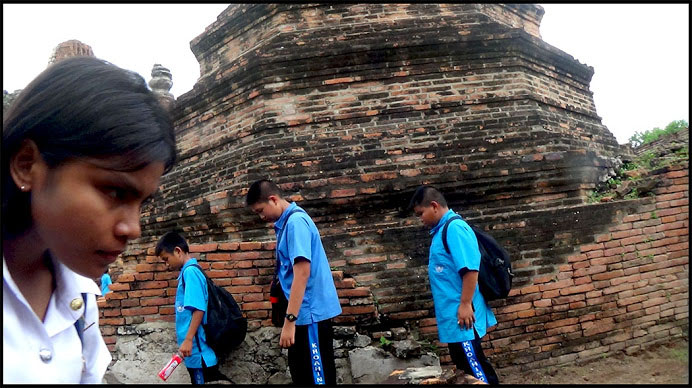 WAT MAHA THAT, Ayutthaya, Thailand
WAT MAHA THAT, Ayutthaya, Thailand
“The design, architecture and decoration of a Khmer temple were modeled according to a series of magical and religious beliefs. Devotees moved from the mundane world to a spiritual one by walking along one of the four axes, each of which has a different astrological value. East, the direction of the rising sun, was auspicious, representing life and the sexual prowess of the male. Most of the Khmer temples were built with the entrance to the east, as this was the formal approach to most Hindu shrines. In general, however, west is considered inauspicious and epresents death, impurity and the setting sun. North is also auspicious, while South has a neutral value. The Khmers adhered to the Hindu belief that a temple must be built correctly according to a mathematical system in order for it to function in harmony with the universe. [11] The sanctuary or the abode of gods was built in the center of the city to imitate Mount Meru which the Khmers believed to be the center of the universe. The town layout, a square-shape, corresponded with the Mandala concept, arising from Hindu beliefs, which indicated the boundary of the universe. [12]”
“All temples in the early period of the establishment of Ayutthaya were clearly Khmer styled, consisting primary of laterite structures (instead of sandstone) and bricks, enhanced with stucco. Wat Maha That consisted basically of a large central prang surrounded by four subsidiary prangs at the four inter-cardinal points, standing on a raised square platform. The quincunx was surrounded by a courtyard and a roofed gallery, lined with a row of Buddha images. Typically for the Ayutthaya period is that often the gallery was penetrated by a monastic structure, being an ordination or an
assembly hall, or even sometimes both. An exception to this was Wat Phutthai Sawan.”
For more information please visit the following link:
https://www.ayutthaya-history.com/Temples_Ruins_MahaThat.html 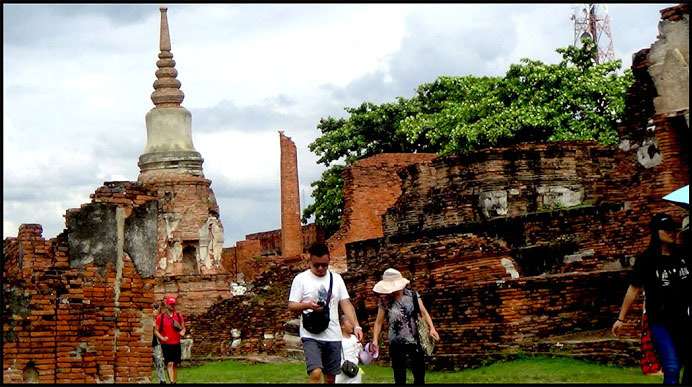 WAT MAHA THAT, Ayutthaya, Thailand
WAT MAHA THAT, Ayutthaya, Thailand
“The principal prang of Wat Maha That was constructed of laterite at the base. The top part of the stupa was of brick and mortar. Brick work at the four sides of the base indicates that the prang had porches in the cardinal directions, a feature not used in the Early Ayutthaya period (1351 – 1491). These porches could be reached by a staircase. Historians believe that these porches were added during the renovation of the temple
done in 1633 during King Prasat Thong’s reign. Mural paintings of Buddhas in the different postures were found inside the prang. The prang stood until the beginning of the 20th century, but finally the brick part collapsed as unfortunately no preserving had been done since the fall of the city in 1767. Fifty years after its collapse a crypt was found containing relics of the Buddha inside the stupa.”
For more information please visit the following link:
https://www.ayutthaya-history.com/Temples_Ruins_MahaThat.html
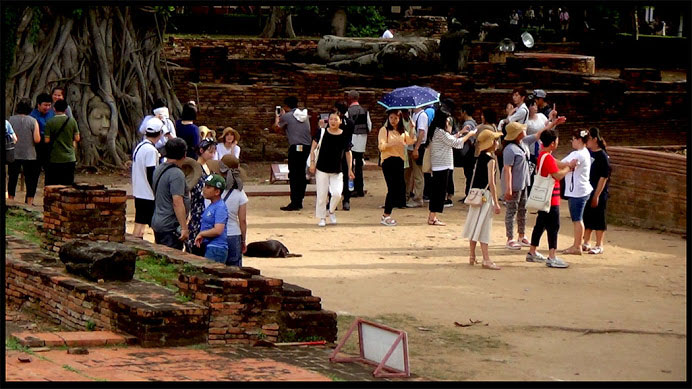 WAT MAHA THAT, Ayutthaya, Thailand
WAT MAHA THAT, Ayutthaya, Thailand
Wat Maha That was certainly not exempted from looting. From its destruction in 1767
until its restoration by the FAD last century, the temple has been prone of severe looting
and damage by illegal excavation.
From the collection of the aerial photograph Peter Williams-Hunt, who took pictures
during reconnaissance missions of Royal Air Force in the 2nd World War, I choose two
photographs to indicated the state of the ruins of Wat Maha That in the year 1946
(photo 1 – photo 2). It is obvious that quite a bit of restoration had been undertaken by
the Fine Arts Department (photo 3).
For more information please visit the following link:
https://www.ayutthaya-history.com/Temples_Ruins_MahaThat.html
 WAT MAHA THAT, Ayutthaya, Thailand
WAT MAHA THAT, Ayutthaya, Thailand
“Excavations: In 1956 the Fine Arts Department started excavations at Wat Maha That. At first
workers, found in the main chamber of the principal prang, half buried in the sand under
the pedestal of the pagoda, a solid gold lion, sitting in a fish-shaped container decorated
with a gilded motif and filled with other gold accessories.
At a later stage the smell of sandalwood oil hung in the air and the upper ventilation hole
of the crypt was found. A shaft was discovered in September, when a vertical
excavation from the floor of the relic chamber was performed.”
For more information please visit the following link:
https://www.ayutthaya-history.com/Temples_Ruins_MahaThat.html
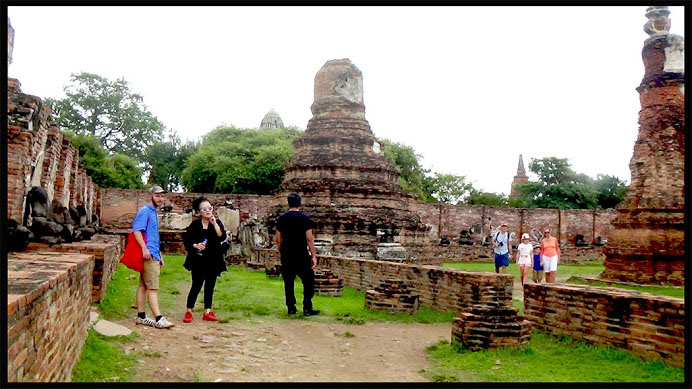 WAT MAHA THAT, Ayutthaya, Thailand
WAT MAHA THAT, Ayutthaya, Thailand
“Aphivan Saipradist recounts the story of one of the workers, Mian Youngpradit, digging
for the crypt in its analysis as follows:
“It was both exciting and tiring. We had only a crow bar and a basket. And we
had to dig just a big enough hole to go through, layer by layer, until we reached
the main crypt 17 meters underneath. We had to use a lantern. But the ventilation
was so poor that breathing became more difficult. We had to lower leafy guava
branches down the hole to help with the ventilation. The noise of the crow bar
touching the stone in the tiny hole was heart wrenching. When it hit the box, the
compressed air suddenly burst out of the tiny hole was so violent that it seemed
like a big serpent jumping at us. If we had not been prepared, it could’ve killed us.
That was how many crypt diggers were killed.” [11]”
For more information please visit the following link:
https://www.ayutthaya-history.com/Temples_Ruins_MahaThat.html
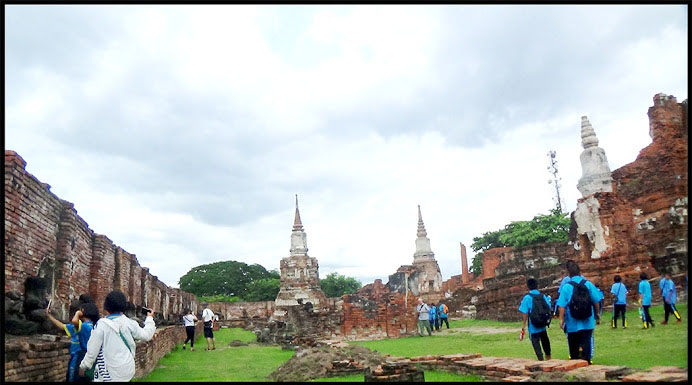 WAT MAHA THAT, Ayutthaya, Thailand
WAT MAHA THAT, Ayutthaya, Thailand
“In the 17-m deep shaft a hollow stone pillar 3.20 m high with a lid buried in a cemented-
brick pedestal was found. Five days were needed to remove it. On 30 August 1956 the
stone container was opened in presence of authorities. The container was filled with a
small stupa wrapped in a lead sheet containing relics, gold ornaments, a large quantity of
bronze images, pewter votive tablets and other valuables.”
For more information please visit the following link:
https://www.ayutthaya-history.com/Temples_Ruins_MahaThat.html
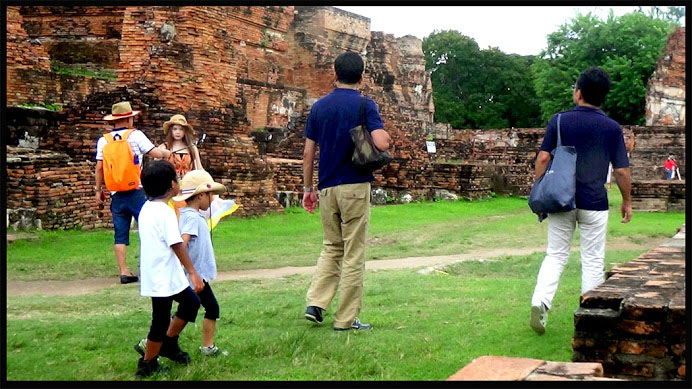 WAT MAHA THAT, Ayutthaya, Thailand
WAT MAHA THAT, Ayutthaya, Thailand
“Jacobus van de Koutere or Jacques de Coutre, born in Bruges (Flanders) around 1572 and a merchant in gemstones gave in his manuscript La Vida de Jaques de Couttre a description of what was likely Wat Maha That. In 1595 de Coutre stayed about 8 months in Ayutthaya as part of an embassy sent to Siam by the Portuguese governor of Malacca. The description you can find here.”
For more information please visit the following link:
https://www.ayutthaya-history.com/Temples_Ruins_MahaThat.html
 WAT MAHA THAT, Ayutthaya, Thailand
WAT MAHA THAT, Ayutthaya, Thailand
“The Royal Chronicles of Ayutthaya state that during King Songtham’s reign (r.
1610/1611-1628) the prang fell in decay and the upper part of the main prang came down.
“In that year the stupa of the Monastery of the Holy Great Relic collapsed right down to the [B: garuda rafters, the foundation and the steps] [CDEF: level of the garudas and its foundation settled].” [8]
Van Vliet although wrote in The short History of the Kings of Siam (1640) that the tower collapsed in the third year of King Prasat Thong’s reign (r. 1629-1656), thus
being 1631.
“In the third year of his reign the golden tower of the Nopphathat suddenly
collapsed without a crosswind, thunder, or lightning. He had it quickly erected
again, but before this tower was totally restored, the scaffolding (beautifully
durably made of bamboo) also collapsed unexpectedly during a rain to
consequence, strange omens were seen but were kept secret by the soothsayers.”
[9]”
For more information please visit the following link:
https://www.ayutthaya-history.com/Temples_Ruins_MahaThat.html
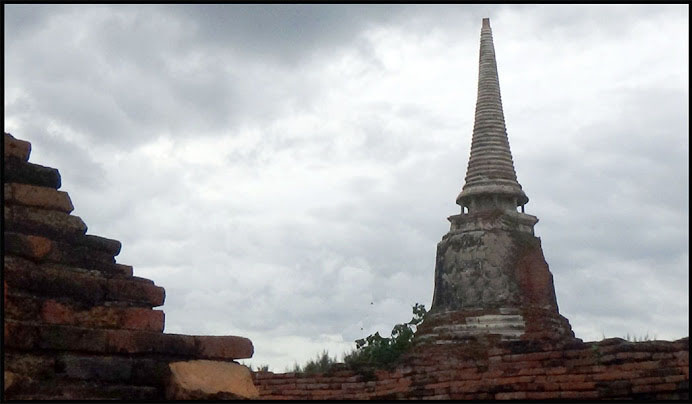 WAT MAHA THAT, Ayutthaya, Thailand
WAT MAHA THAT, Ayutthaya, Thailand
“Prasat Thong restored the stupa in 1633 and increased it considerably. Theprang was raised to 44 meters and reached at that time, with its finial, a height of 50 m.
“In 995 (1633 AD), a year of the cock, the King in His holy compassion had the
holy stupa of the Monastery of the Great Relic, which had been destroyed earlier, restored. Originally the main section had been nineteen wa, with a sky trident spire of three wa, so the King said, “The original form was extremely squat. Rebuild it so it is a sen and two wa high but retain the sky trident spire so that together they equal one sen and five wa.” When it was built it looked conical and it was ordered that makha wood be brought and added to the brick and that mortar be taken and added to it. In nine months it was completed and a ceremony to dedicate it was
ordered to be held on a grand scale.” [10]
Wat Maha That was restored again in King Borommakot’s reign (r. 1733-1758). Four porticos were added to the prang, which was restored at the same time as the royal vihara and the ordination hall. No evidence of restoration of the monastery could be found after. Obviously chedis, prangs, and viharns were added on several occasions in time. At the fall of Ayutthaya in 1767, the monastery was set on fire in the Burmese
attack.”
For more information please visit the following link:
https://www.ayutthaya-history.com/Temples_Ruins_MahaThat.html
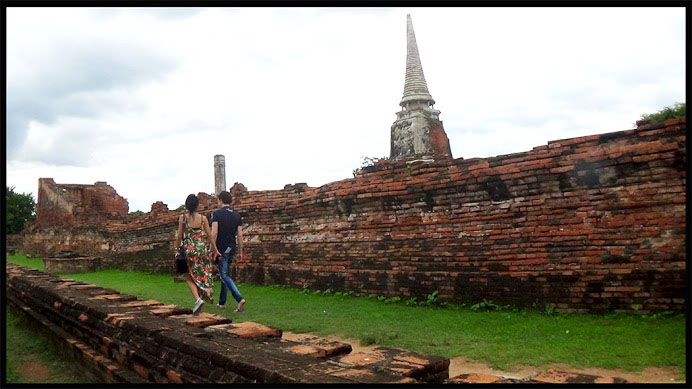 WAT MAHA THAT, Ayutthaya, Thailand
WAT MAHA THAT, Ayutthaya, Thailand
“Wat Maha That housed before an unusual Buddha image of green stone believed to be
made in the Dvaravati style (Mon) dating from 707 – 757 AD. A governor of Ayutthaya
got this statue moved to Wat Na Phra Men during the reign of King Rama III, where it
still resides in a small vihara next to the ubosot.
The main prang of Wat Maha That survived until the reign of King Rama V, as seen in a
photograph taken in 1903, early 1904. On 25 May, 1904, at 0500 Hr in the morning,
the main prang collapsed at the level of the niche. The prang fell further apart in 1911
during the reign of King Rama VI. The Fine Arts Department restored it partially. The
symmetrical base with staircases on the four sides is all what remains of the once
majestic prang.”
For more information please visit the following link:
https://www.ayutthaya-history.com/Temples_Ruins_MahaThat.html
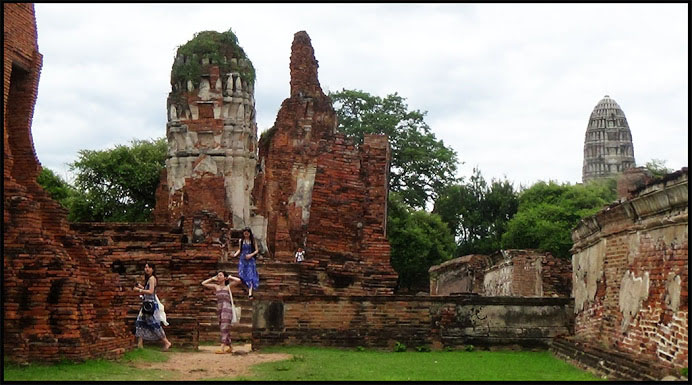 WAT MAHA THAT, Ayutthaya, Thailand
WAT MAHA THAT, Ayutthaya, Thailand
Wat Maha That or the Monastery of the Great Relic is located on the city island in
the central part of Ayutthaya in Tha Wasukri sub-district. The temple is situated on the
corner of the present Chikun Road and Naresuan Road. The monastery stood on the
west bank of Khlong Pratu Khao Pluak, an important canal, which has been filled up
somewhere in the early 20th century. In ancient times the temple was likely fully
surrounded by canals and moats. The structure has been registered as a national historic
site by the Fine Arts Department on 8 March 1935 and is part of the Ayutthaya World
Heritage Historical Park.
or more information please visit the following link:
https://www.ayutthaya-history.com/Temples_Ruins_MahaThat.html
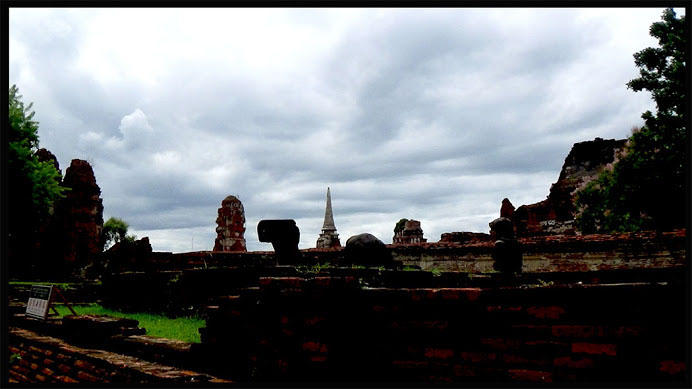 WAT MAHA THAT, Ayutthaya, Thailand
WAT MAHA THAT, Ayutthaya, Thailand
History: The exact date of the establishment of Wat Maha That is difficult to assess.
The Luang Prasoet version of the Royal Chronicles of Ayutthaya put its construction in
736 Chula Sakarat (CS) or 1374 of the Christian Era, during the reign of King
Borommaracha I (r. 1370-1388), somehow 23 years after the establishment of
Ayutthaya. The chronicles mention that the central prang had a height of 46 meter.
“In 736, a year of the tiger, King Bòromracha I and the Venerable
Thammakanlayan first erected the great, glorious, holy jeweled reliquary,
towering one sen and three wa, to the east of the royal lion gable.” [1]
Later versions of the Royal Chronicles of Ayutthaya state that Wat Maha That was
established by King Ramesuan (r. 1388-1395) after his attack of Chiang Mai in 1384
(746 CS). But this date is not corroborating with his period of reign.
“Then the King went out to observe the precepts at Mangkhalaphisek Hall. At ten
thum he looked toward the east and saw a Great Holy Relic of the Lord Buddha
performing a miracle. Calling the palace deputies to bring his royal palanquin, he
rode forth. He had stakes brought and pounded into the ground to mark the spot.
The great holy reliquary which he built there was nineteen wa high, with a nine-
branched finial three wa high, and named the Maha That Monastery. Then the
King had the Royal Rite of Entering the Capital performed and festivities were
held in the royal residence.” [2]
For more information please visit the following link:
https://www.ayutthaya-history.com/Temples_Ruins_MahaThat.html
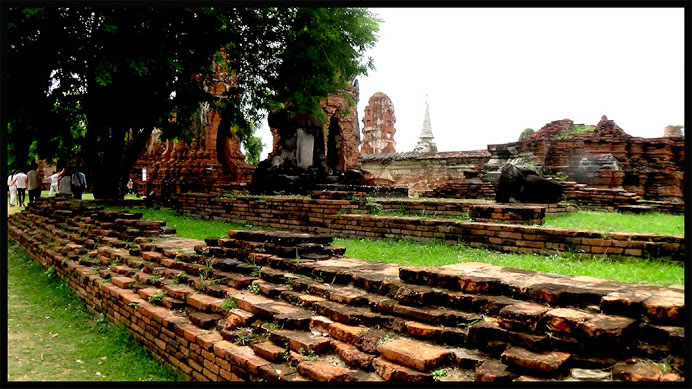 WAT MAHA THAT, Ayutthaya, Thailand
WAT MAHA THAT, Ayutthaya, Thailand
“In general, historians bet on the two horses and take as granted that the construction of
the monastery was started by King Borommaracha I and completed in King Ramesuan’s
reign. In the second version the prang was 38 meter high with on top, a finial of 6 meter.
An earlier source (1), Jeremias Van Vliet, a chief merchant of the Dutch East India
Company in Ayutthaya, wrote in his Short History of the Kings of Siam in 1640, that it
was Prince U-Thong, the later King Ramathibodhi I, who built Wat Maha That.
“Then Thao U Thong began to re-establish the city on the fifth day of the waxing
fourth moon (in our reckoning being the month of March) in the Year of the Tiger
and called it Ayutthaya. He also built three temples which are still considered to be
the most important in the whole kingdom: the Nopphathat, the most holy;
Ratchaburana, the same size and shape as the Nopphathat but not visited by the
kings because of a prophecy that the first king who goes in there will die shortly
thereafter; and Wat Doem still the foremost [monastic?] school. After Thao U
Thong had built the aforementioned city, he had the entire population called
together and declared himself king.” [3]
The chronicles mention that King Borommaracha II (r. 1424-1448) attacked Angkor
in 1431 and had a large number of sacred images of oxen, lions and other creatures
removed from the temples there. These images were brought to Ayutthaya and installed
as offerings at Wat Maha That.”
For more information please visit the following link:
https://www.ayutthaya-history.com/Temples_Ruins_MahaThat.html
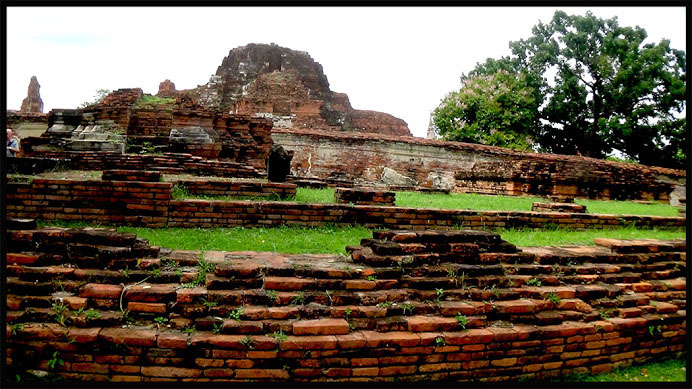 WAT MAHA THAT, Ayutthaya, Thailand
WAT MAHA THAT, Ayutthaya, Thailand
Welcome To My Beloved Country, Thailand
Photograph by Ing-On Vibulbhan-Watts
“Wat Maha That was one of the most important monasteries of the Ayutthaya kingdom,
not only because it was the religious centre and enshrined relics of the Buddha, but also
because of its proximity to the Grand Palace. It was a royal monastery and the seat of
the Supreme Patriarch of the City Dwelling sect till the end of the Ayutthaya period – at
par with the Supreme Patriarch of the Forest Dwelling sect, which had its seat at Wat
Yai Chai Mongkhon (called Wat Pa Kaeo in earlier times). Van Vliet wrote in 1638 in
his Description of the Kingdom of Siam that from the highest ecclesiastic regents,
namely the four bishops of the principal temples of Judia, “The bishop of the Nappetat
(2) has the supreme dignity” [5]
In the past, it was the venue of important royal ceremonies and celebrations. Van Vliet
describes the splendor of yearly Royal procession to Wat Maha That on the occasion of
Kathin, where the Ayutthayan Kings “made their offerings to the gods and prayed for
the welfare of the country”. An excerpt from The Description of the Kingdom of
Siam of 1638 can be read here [7].”
For more information please visit the following link:
https://www.ayutthaya-history.com/Temples_Ruins_MahaThat.html


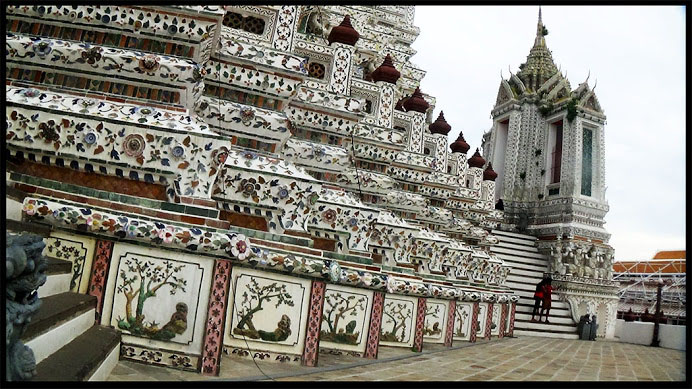
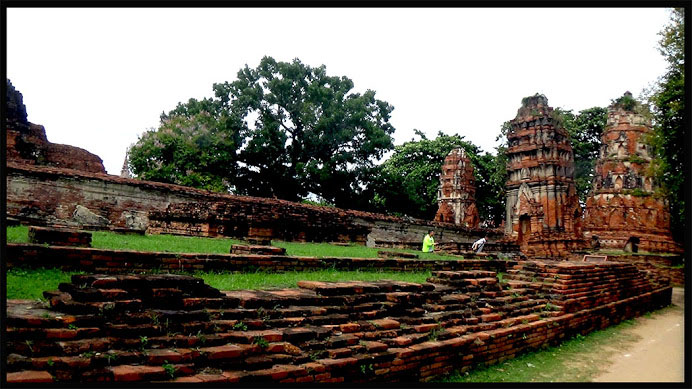
Leave a Reply